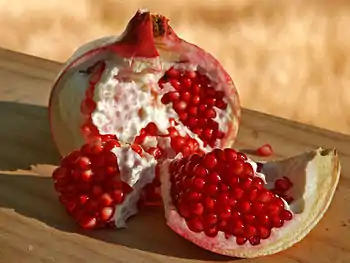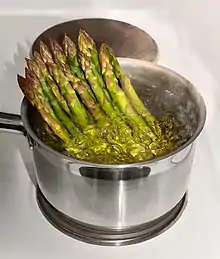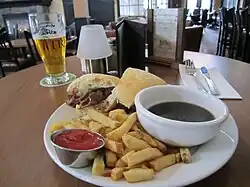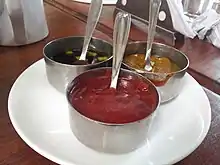Portal:Food
F o o d
A portal dedicated to food and foodways
Introduction
.jpg.webp)
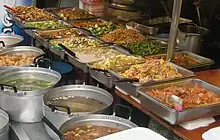
Food is any substance consumed by an organism for nutritional support. Food is usually of plant, animal, or fungal origin and contains essential nutrients such as carbohydrates, fats, proteins, vitamins, or minerals. The substance is ingested by an organism and assimilated by the organism's cells to provide energy, maintain life, or stimulate growth. Different species of animals have different feeding behaviours that satisfy the needs of their metabolisms and have evolved to fill a specific ecological niche within specific geographical contexts.
Omnivorous humans are highly adaptable and have adapted to obtain food in many different ecosystems. Humans generally use cooking to prepare food for consumption. The majority of the food energy required is supplied by the industrial food industry, which produces food through intensive agriculture and distributes it through complex food processing and food distribution systems. This system of conventional agriculture relies heavily on fossil fuels, which means that the food and agricultural systems are one of the major contributors to climate change, accounting for as much as 37% of total greenhouse gas emissions. (Full article...)
Cooking, also known as cookery or professionally as the culinary arts, is the art, science and craft of using heat to make food more palatable, digestible, nutritious, or safe. Cooking techniques and ingredients vary widely, from grilling food over an open fire to using electric stoves, to baking in various types of ovens, reflecting local conditions.
Preparing food with heat or fire is an activity unique to humans. Archeological evidence of cooking fires from at least 300,000 years ago exists, but some estimate that humans started cooking up to 2 million years ago.
The expansion of agriculture, commerce, trade, and transportation between civilizations in different regions offered cooks many new ingredients. New inventions and technologies, such as the invention of pottery for holding and boiling of water, expanded cooking techniques. Some modern cooks apply advanced scientific techniques to food preparation to further enhance the flavor of the dish served. (Full article...)
 Good article –
Good article –
Aeroplane Jelly is a jelly brand in Australia created in 1927 by Bert Appleroth. Appleroth's backyard business, Traders Pty Ltd, became one of Australia's largest family-operated food manufacturers and was sold to McCormick Foods Australia, a subsidiary of United States corporation McCormick & Company, in 1995. Aeroplane Jelly is the market leader in Australia's jelly market, with over 18 million packets sold annually. Strawberry is the best-selling flavour.
Aeroplane Jelly ran a successful advertising campaign featuring a jingle that has become part of Australian culture. It is one of Australia's longest-running jingles, recorded in 1937 featuring the voice of five-year-old Joy King. It was played on radio over 100 times per day in the 1940s. The jingle was added to the National Film and Sound Archive's Sounds of Australia registry in 2008. (Full article...)
Selected article –
.jpg.webp)
Selected cuisine -
Australian cuisine is the food and cooking practices of Australia and its inhabitants. Australia has absorbed culinary contributions and adaptations from various cultures around the world, including British, European, Asian and Middle Eastern.
Indigenous Australians have occupied Australia for some 65,000 years, during which they developed a unique hunter-gatherer diet, known as bush tucker, drawn from regional Australian plants and animals. Australia became a collection of British colonies from 1788 to 1900, during which time culinary tastes were strongly influenced by British and Irish migrants, with agricultural products such as beef cattle, sheep and wheat becoming staples in the local diet. The Australian gold rushes introduced more varied immigrants and cuisines, mainly Chinese, whilst post-war immigration programs led to a large-scale diversification of local food, mainly due to the influence of migrants from the Mediterranean, East Asia and South Asia. (Full article...)Selected ingredient –

Garam masala (from Hindustani گرم مصالحہ/गरम मसाला garm masala, "hot spices") is a blend of ground spices originating from the Indian subcontinent. It is common in Indian, Pakistani, Nepalese, Bangladeshi, Sri Lankan and Caribbean cuisines. It is used alone or with other seasonings. The specific fixings differ by district, but it regularly incorporates a blend of flavors like cardamom, cinnamon, cumin, cloves and peppercorns. Garam masala can be found in a wide range of dishes, including marinades, pickles, stews, and curries. (Full article...)
Selected recipe –
A French dip sandwich, also known as a beef dip, is a hot sandwich consisting of thinly sliced roast beef (or, sometimes, other meats) on a "French roll" or baguette. It is usually served plain but a popular variation is to top with Swiss cheese, onions, and a dipping container of beef broth produced from the cooking process (termed au jus, "with juice"). Beef stock, a light beef gravy, or beef consommé is sometimes substituted. The sandwich is an American invention, with the name seeming to refer to the style of bread, rather than any French origin. Although the sandwich is most commonly served with a cup of jus or broth on the side of the plate, into which the sandwich is dipped as it is eaten, this is not how the sandwich was served when it was originally developed.
Two Los Angeles restaurants have claimed to be the birthplace of the French dip sandwich: Cole's Pacific Electric Buffet and Philippe the Original. Philippe's website describes the dish as a "specialty of the house", and the words "Home of the Original French Dip Sandwich" are present in the restaurant's logo. At Phillippe's, the roll is dipped in the hot beef juices before the sandwich is assembled, and is served "wet", while at Cole's it is served with a side of beef juices. The sandwich can also be requested "double dipped", where both halves of the sandwich are dipped before serving, at either establishment. Both restaurants feature their own brand of spicy mustard that is traditionally used by patrons to complement the sandwich. (Full article...)
 Featured article –
Featured article –
La Stazione may refer to:
- La stazione (1952 film), a documentary by Valerio Zurlini
- La stazione, or The Station (1990 film), an Italian comedy-drama by Sergio Rubini
- New Paltz station, New York, a former railroad station occupied by a restaurant formerly known as La Stazione (Full article...)
Selected image –
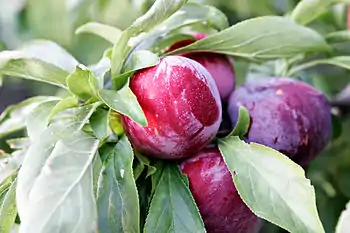
Selected biography –

B. February 11, 1926 – d. January 20, 2018
Paul François Pierre Bocuse (French pronunciation: [pɔl bɔkyz]; 11 February 1926 – 20 January 2018) was a French chef based in Lyon known for the high quality of his restaurants and his innovative approaches to cuisine. Dubbed "the pope of gastronomy", he was affectionately nicknamed Monsieur Paul (Mister Paul). The Bocuse d'Or, a biennial world chef championship, bears his name.
A student of Eugénie Brazier, he was one of the most prominent chefs associated with the nouvelle cuisine, which is less opulent and calorific than the traditional cuisine classique, as well as stresses the importance of fresh ingredients of the highest quality. Bocuse claimed that Henri Gault first used the term, nouvelle cuisine, to describe food prepared by Bocuse and other top chefs for the maiden flight of the Concorde airliner in 1969. (Full article...)
Did you know (auto-generated) –
- ... that live huhu grubs have been served at the Hokitika Wildfoods Festival?
- ... that after Musical Youth reworked the song "Pass the Kouchie" into "Pass the Dutchie" by replacing cannabis references with food references, the word "dutchie" later became a cannabis reference as well?
- ... that Juan José Cabezudo was an openly gay chef and street-food seller in 19th-century Lima?
- ... that a 1947 song tells you how to cook rabbit at top speed?
- ... that a British supermarket uses barriers to prevent shoppers grabbing food with yellow discount stickers out of the hands of staff?
- ... that the termite Odontotermes formosanus grows its own food?
More did you know –
Related portals
Food topics
The following are topics relating to food
Categories
The following are categories relating to food.
![]()
Food list articles
- See also: Lists of foods and Category:Lists of drinks
The following are some Food list articles on Wikipedia:
- American cheeses
- Appellation d'Origine Contrôlée cheeses
- Apple cultivars
- Bacon dishes
- Bacon substitutes
- Basil cultivars
- Breads
- Breakfast beverages
- Breakfast cereals
- Breakfast foods
- British cheeses
- Cakes
- Candies
- Cheeses
- Cheese soups
- Christmas dishes (list)
- Cocktails
- Cookies
- Dishes using coconut milk
- Diets
- Doughnut varieties
- Egg dishes
- Fermented soy products
- Food additives
- Food additives (Codex Alimentarius)
- Foods named after people
- French cheeses
- French dishes
- Fried dough foods
- Fruits
- List of hamburgers
- Herbs and spices
- Hors d'oeuvre
- Indian dishes
- Indian snack foods
- Indonesian dishes
- Italian dishes
- Japanese snacks
- Japanese dishes
- Jewish dishes
- Kebabs
- Korean beverages
- Mango cultivars
- Moroccan dishes
- Pasta
- Pastries
- Philippine snack food
- Pies, tarts and flans
- Poppy seed pastries and dishes
- Potato dishes
- Puddings
- Raw fish dishes
- Rice dishes
- Rolled foods
- Sauces
- Seafood
- Seeds
- Sandwiches
- Snack foods
- Soft drinks by country
- Soul foods and dishes
- Soups
- Stews
- Street foods
- Tapas
- Turkish dishes
- Twice-baked foods
- Vegetable oils
- Vegetables
- Vodkas
Things you can do
 |
Here are some tasks awaiting attention:
|
Related WikiProjects
| Parent project: WikiProject Food and Drink | view |
| Child projects: | Task forces: (All inactive) |
|
|
| Related projects: | |
|
New articles
Rules | Match log | Results page (for watching) | Last updated: 2023-10-27 19:24 (UTC)
Note: The list display can now be customized by each user. See List display personalization for details.
- Eastern Cafe (edit | talk | history | links | watch | logs | tools) by Another Believer (talk · contribs · new pages (125)) started on 2023-10-27, score: 10
- Kim T'ae-so (edit | talk | history | links | watch | logs | tools) by CountHacker (talk · contribs · new pages (9)) started on 2023-10-27, score: 10
- Pão francês (edit | talk | history | links | watch | logs | tools) by BaduFerreira (talk · contribs · new pages (12)) started on 2023-10-26, score: 10
- Allen & Delancey (edit | talk | history | links | watch | logs | tools) by Another Believer (talk · contribs · new pages (125)) started on 2023-10-25, score: 10
- Kretscham (edit | talk | history | links | watch | logs | tools) by Bermicourt (talk · contribs · new pages (21)) started on 2023-10-26, score: 20
- Food Research International (edit | talk | history | links | watch | logs | tools) by LeonardoSmi (talk · contribs · new pages (7)) started on 2023-10-26, score: 10
- Foods (journal) (edit | talk | history | links | watch | logs | tools) by LeonardoSmi (talk · contribs · new pages (7)) started on 2023-10-26, score: 10
- Journal of Functional Foods (edit | talk | history | links | watch | logs | tools) by LeonardoSmi (talk · contribs · new pages (7)) started on 2023-10-26, score: 10
- Xinghuacun Fenjiu (edit | talk | history | links | watch | logs | tools) by Greenman (talk · contribs · new pages (4)) started on 2023-10-25, score: 10
- Dan Yakir (edit | talk | history | links | watch | logs | tools) by Tzahy (talk · contribs · new pages (1)) started on 2023-10-25, score: 10
- The Chastain (edit | talk | history | links | watch | logs | tools) by Another Believer (talk · contribs · new pages (125)) started on 2023-10-25, score: 10
- Marie Wong (edit | talk | history | links | watch | logs | tools) by DrThneed (talk · contribs · new pages (15)) started on 2023-10-25, score: 10
- Bellaire Goblet Company (edit | talk | history | links | watch | logs | tools) by TwoScars (talk · contribs · new pages (2)) started on 2023-10-24, score: 10
- Areias (Portuguese food) (edit | talk | history | links | watch | logs | tools) by Chedlund808 (talk · contribs · new pages (21)) started on 2023-10-24, score: 60
- PickMe Food (edit | talk | history | links | watch | logs | tools) by Mithila Madawa Gunathilake (talk · contribs · new pages (2)) started on 2023-10-23, score: 10
- Azevia (edit | talk | history | links | watch | logs | tools) by Chedlund808 (talk · contribs · new pages (21)) started on 2023-10-23, score: 10
- Doce de gila (edit | talk | history | links | watch | logs | tools) by Chedlund808 (talk · contribs · new pages (21)) started on 2023-10-22, score: 30
- Bolo de bolacha (edit | talk | history | links | watch | logs | tools) by Chedlund808 (talk · contribs · new pages (21)) started on 2023-10-21, score: 10
- Fuel Coffee & Books (edit | talk | history | links | watch | logs | tools) by Another Believer (talk · contribs · new pages (125)) started on 2023-10-21, score: 10
- Harry Titchmarsh (edit | talk | history | links | watch | logs | tools) by EchetusXe (talk · contribs · new pages (3)) started on 2023-10-21, score: 10
- Celeste Wong (edit | talk | history | links | watch | logs | tools) by Bogger (talk · contribs · new pages (10)) started on 2023-10-21, score: 20
- Pão de rala (edit | talk | history | links | watch | logs | tools) by ForsythiaJo (talk · contribs · new pages (97)) started on 2023-10-21, score: 10
- Russian cheese (edit | talk | history | links | watch | logs | tools) by Akeosnhaoe (talk · contribs · new pages (4)) started on 2023-10-21, score: 30
- Rush Munro's (edit | talk | history | links | watch | logs | tools) by Panamitsu (talk · contribs · new pages (43)) started on 2023-10-19, score: 20
- Diet Coke (edit | talk | history | links | watch | logs | tools) by 149.19.33.121 (talk · contribs · new pages (1)) started on 2023-10-19, score: 20
- Hmongtown Marketplace (edit | talk | history | links | watch | logs | tools) by Pingnova (talk · contribs · new pages (7)) started on 2023-10-18, score: 10
- Spinnin (Madison Beer song) (edit | talk | history | links | watch | logs | tools) by 2A00:23C6:9B41:AF01:1DBB:6835:BA40:5DE2 (talk · contribs · new pages (1)) started on 2023-10-19, score: 10
- Busan KCC Egis (edit | talk | history | links | watch | logs | tools) by Snowflake91 (talk · contribs · new pages (1)) started on 2023-10-19, score: 10
- Bannu Pulao (edit | talk | history | links | watch | logs | tools) by Pukhtun zalmai (talk · contribs · new pages (3)) started on 2023-10-19, score: 10
- Steal a Base, Steal a Taco (edit | talk | history | links | watch | logs | tools) by White 720 (talk · contribs · new pages (2)) started on 2023-10-19, score: 10
- Barbara Ann's Bar-B-Que (edit | talk | history | links | watch | logs | tools) by AllWeKnowOfHeaven (talk · contribs · new pages (4)) started on 2023-10-19, score: 10
- French roll (edit | talk | history | links | watch | logs | tools) by Melsj (talk · contribs · new pages (11)) started on 2023-10-19, score: 10
- Russell's Barbecue (edit | talk | history | links | watch | logs | tools) by AllWeKnowOfHeaven (talk · contribs · new pages (4)) started on 2023-10-19, score: 10
- Fire Department Coffee (edit | talk | history | links | watch | logs | tools) by MicrobiologyMarcus (talk · contribs · new pages (31)) started on 2023-10-18, score: 20
- Primo (milk) (edit | talk | history | links | watch | logs | tools) by Panamitsu (talk · contribs · new pages (43)) started on 2023-10-18, score: 20
- Cullen Gilchrist (edit | talk | history | links | watch | logs | tools) by Kelmaa (talk · contribs · new pages (1)) started on 2023-10-18, score: 10
- Mizone (edit | talk | history | links | watch | logs | tools) by Yucalyptus (talk · contribs · new pages (1)) started on 2023-10-18, score: 10
- Orior (company) (edit | talk | history | links | watch | logs | tools) by Mister Bucket (talk · contribs · new pages (1)) started on 2023-10-17, score: 20
- List of broccoli dishes (edit | talk | history | links | watch | logs | tools) by WikiUser70176 (talk · contribs · new pages (1)) started on 2023-10-17, score: 20
- Pizzaman-Chickenman (edit | talk | history | links | watch | logs | tools) by DaSupremo (talk · contribs · new pages (2)) started on 2023-10-16, score: 10
- Goody Goody Gum Drops (edit | talk | history | links | watch | logs | tools) by Panamitsu (talk · contribs · new pages (43)) started on 2023-10-16, score: 20
- Fiber One (edit | talk | history | links | watch | logs | tools) by SomeBodyAnyBody05 (talk · contribs · new pages (18)) started on 2023-10-16, score: 10
- Suika Game (edit | talk | history | links | watch | logs | tools) by TechnicalNewt (talk · contribs · new pages (3)) started on 2023-10-16, score: 20
- Fish fork (edit | talk | history | links | watch | logs | tools) by SilverLocust (talk · contribs · new pages (27)) started on 2023-10-16, score: 10
- Bánh trôi (edit | talk | history | links | watch | logs | tools) by Otomo Ajah (talk · contribs · new pages (5)) started on 2023-10-16, score: 30
- List of vodka brands (edit | talk | history | links | watch | logs | tools) by John baost (talk · contribs · new pages (6)) started on 2023-10-16, score: 10
- Tico Mineiro (edit | talk | history | links | watch | logs | tools) by Svartner (talk · contribs · new pages (139)) started on 2023-10-16, score: 10
- Hyperpalatable food (edit | talk | history | links | watch | logs | tools) by AndrewNJ (talk · contribs · new pages (11)) started on 2023-10-15, score: 20
- Chha trob (edit | talk | history | links | watch | logs | tools) by Turaids (talk · contribs · new pages (5)) started on 2023-10-14, score: 10
- Fish knife (edit | talk | history | links | watch | logs | tools) by Викидим (talk · contribs · new pages (13)) started on 2023-10-14, score: 10
- Kōʻelepālau (edit | talk | history | links | watch | logs | tools) by Chedlund808 (talk · contribs · new pages (21)) started on 2023-10-13, score: 20
- Aviko (edit | talk | history | links | watch | logs | tools) by Jan1743 (talk · contribs · new pages (2)) started on 2023-10-13, score: 10
- Aroma Joe's (edit | talk | history | links | watch | logs | tools) by Bkissin (talk · contribs · new pages (15)) started on 2023-10-13, score: 30
- Rice as food (edit | talk | history | links | watch | logs | tools) by Chiswick Chap (talk · contribs · new pages (6)) started on 2023-10-13, score: 10
- Sunrise Soya Foods (edit | talk | history | links | watch | logs | tools) by Abigbagel (talk · contribs · new pages (7)) started on 2023-10-13, score: 20
Associated Wikimedia
The following Wikimedia Foundation sister projects provide more on this subject:
-
 Commons
Commons
Free media repository -
 Wikibooks
Wikibooks
Free textbooks and manuals -
 Wikidata
Wikidata
Free knowledge base -
 Wikinews
Wikinews
Free-content news -
 Wikiquote
Wikiquote
Collection of quotations -
 Wikisource
Wikisource
Free-content library -
 Wikiversity
Wikiversity
Free learning tools -
 Wiktionary
Wiktionary
Dictionary and thesaurus
Sources
More portals
-
 List of all portalsList of all portals
List of all portalsList of all portals -
 The arts portal
The arts portal -
 Biography portal
Biography portal -
 Current events portal
Current events portal -
 Geography portal
Geography portal -
 History portal
History portal -
 Mathematics portal
Mathematics portal -
 Science portal
Science portal -
 Society portal
Society portal -
 Technology portal
Technology portal -
 Random portalRandom portal
Random portalRandom portal -
 WikiProject PortalsWikiProject Portals
WikiProject PortalsWikiProject Portals







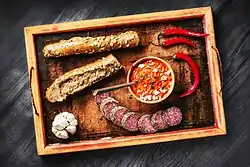





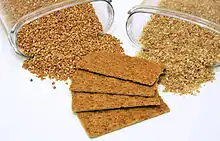



.jpg.webp)
